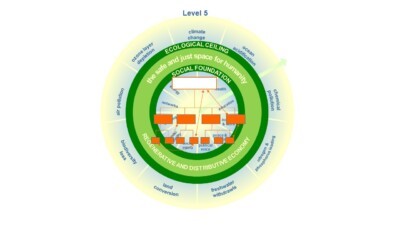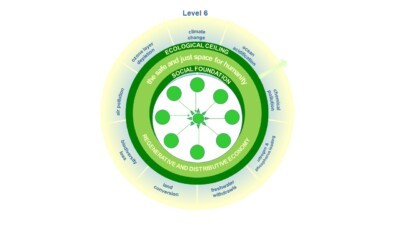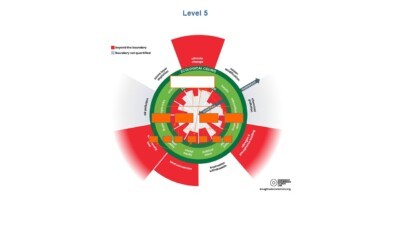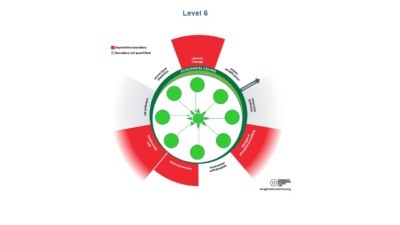Thought Experiment 4 Regionalcentric Worldview: Spiral Dynamics, Integral City & Doughnut Economics
We continue our Thought Experiment in this instalment by looking at Doughnut Economics (DE) and its relationship to Spiral Dynamics and Integral City through a Regionalcentric Worldview.

As we noted in our first blog, the Regionalcentric Worldview spans Levels 5 and 6 in Spiral Dynamics (see Table 4). A regionalcentric worldview embraces the structures of Strategic Enterprise and Social Safety Network.
Table 4: Regionalcentric Worldview, Spiral Dynamics, Archetypal Structure
WorldviewSpiral Dynamics Level of ComplexitySpiral Dynamics ExpressionArchetypal StructureRegionalcentricLevel 5Orange – IndividualStrategic EnterpriseLevel 6Green – CollectiveSocial Safety NetworkWe can summarize the inner qualities and outer contexts of these 2 levels complexity as set out in Figures 6 and 7.
Figure 6

Figure 7

As we are examining the correlative life conditions that Doughnut Economics points to, we can look back historically at the inner and outer factors of DE and see the expansion from regional influence into a global commercialization commenced the rocky road toward the unbalancing of the Ecological Ceiling and Social Justice factors. Historically, the kinds of human settlements that emerged at these stages are what we would now call modern and postmodern (even Smart and Resilient) cities now stretching the balance of local and regional life conditions into a global reach because of the technological developments that enabled this possibility.
At the fifth level of complexity, DE Inner factors included building on the life conditions of earlier levels include energy (intensive fossil-fuel and early renewable energy) and intensified performance related to Income and Work, a more assertive Political Voice with Education, Health and Social Equity organized into public, private and not-for-profit performance enterprises . Outer factors expanded to include nitrogen and phosphorous loading (caused by industrialized agriculture practices) air pollution (from burning fossil fuels) ozone layer depletion, and intensified land conversion (to capture the commodity and biological resources for industrial use). The earlier factors continued to be threatened with fresh water drawdown, biodiversity loss (as natural habitats are invaded by regional and global enterprises).
The Level 5/Orange Spiral Dynamic factors are oriented to the individual with the focus on results, growth strategies, competitive labour forces, and global agreements for the exploitation of energy, food and water. Furthermore, the industrialization process led to the expanded privatization of healthcare, education, housing and land/property ownership. The Human System Context that set the life conditions at this level of complexity were a capitalist influenced government, with effective efficient functional departments. In democracies this phase tended to be anti-union, with continued globalization of resources, a divestment of colonial governance but a continuation of colonial commercial influence, and an expectation that land, water and air sheds were available to be exploited.
At the sixth level of complexity, DE Inner factors expanded from the fifth level’s factors to include education, health, social equity (for most definitions of diversity), gender equity (with equality for both women and men), regional and even global agreements for peace and justice. Energy starts to be delivered from renewable sources of water, wind and solar. Outer factors continued to deteriorate, and the specter of climate change became more fully recognized but with few intentions to change the underlying causes. This became characterized by the “inconvenient truths” that could be named but seemed too costly to act on.
The Level 6/Green Spiral Dynamic factors are oriented to the collective with the worldview still regionalcentric with many global characteristics or networks emerging. A sense of global citizenship started to emerge from the regional affinities, that also spawned transnational human rights initiatives. At the same time people started to recognize environmental protection was needed for the basics of life and even Nature (as forest, water, air, soil). Private, public and NFP options emerged for health, education, housing, land, energy, food and water. The Human System Context favoured an increasing interest in Socialist governance (as a counteraction to the privatizing interests represented by Capitalism). With world courts and strong social activism Social Justice became globalized. Truth and Reconciliation processes emerged and the rights of Indigenous people were demanded (if not granted). Environmental activism supported Nature, Land, Water, Air quality
Thus, DE helps to reveal the undeniable interconnection of Social Justice factors and the encroachment on our Ecological Ceiling. At this stage of emergence, the great challenge is to make the “walk” match the “talk”. The alarm bells start ringing, but people are either frozen in place (from fear) or ignore them (expecting technology to solve the problems.)
Looking at human habitations in 21st century, at these fifth and sixth stages, we can consider the implications that these worldviews and capacities have had on the effectiveness of economies. The influence that is amplified when strategies are focused on growth that expands to globalization, means that Social and Justice factors become more visible locally while becoming more untenable globally. These worldviews live in a tension between the strategic growth focus and the increasingly loud call for Social Justice that resonates around the world, acting as if they are blind to the increasingly endangered Ecological Ceiling while disconnecting these factors from their impact on Social Justice.
These regionalized human settlements have global aspiration to continue to accumulate wealth that it is expected will be invested in technology to solve the overreaches of the Ecological Ceiling. The continued practice of ignoring the dangers of not living within the Ecological Ceilings and their links with Social Justice factors for all people increases the local, regional and global tensions, causing climate, water, energy refugees and threatening the whole spiral of structures within the regions and a planet of cites – as illustrated in the recalibrated Levels 5 and Level 6 below representing the planetary challenges we are now experiencing.


This series of Thought Experiments consider: How do the Spiral Dynamics integral worldviews of humans living in cities impact the Social Justice and Ecological Ceiling dimensions represented in Doughnut Economics? The blog series includes the following:
Integral City Thought Experiment 1: Exploring Doughnut Economics & Spiral DynamicsThought Experiment 2 Egocentric Worldview: Spiral Dynamics, Integral City & Doughnut EconomicsThought Experiment 3 Ethnocentric Worldview: Spiral Dynamics, Integral City & Doughnut EconomicsThought Experiment 4 Regionalcentric Worldview: Spiral Dynamics, Integral City & Doughnut EconomicsThought Experiment 5 Globalcentric Worldview: Spiral Dynamics, Integral City & Doughnut EconomicsMarilyn Hamilton's Blog
- Marilyn Hamilton's profile
- 3 followers



